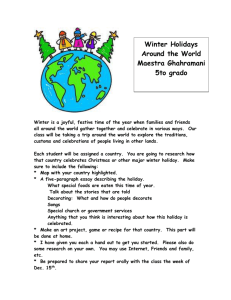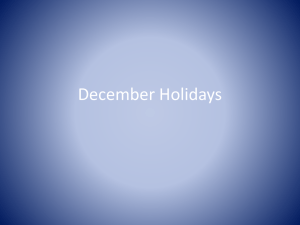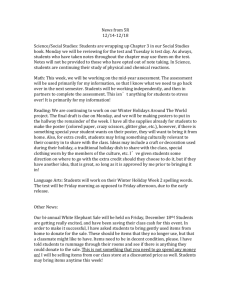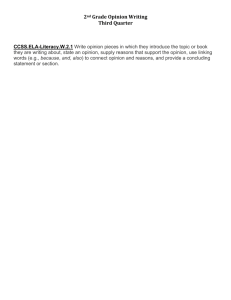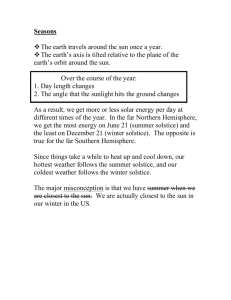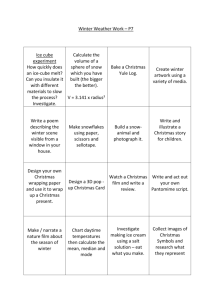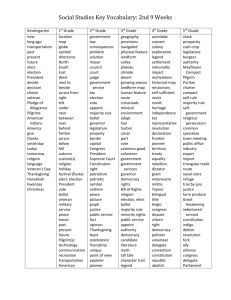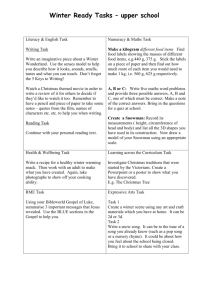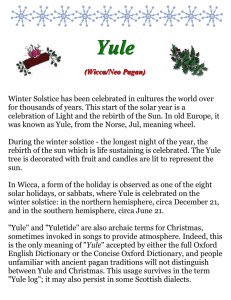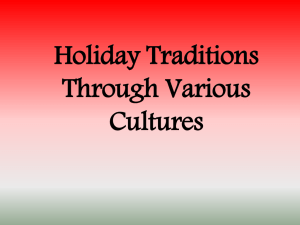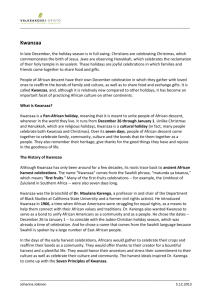vocabulary list - Amazing Teacher
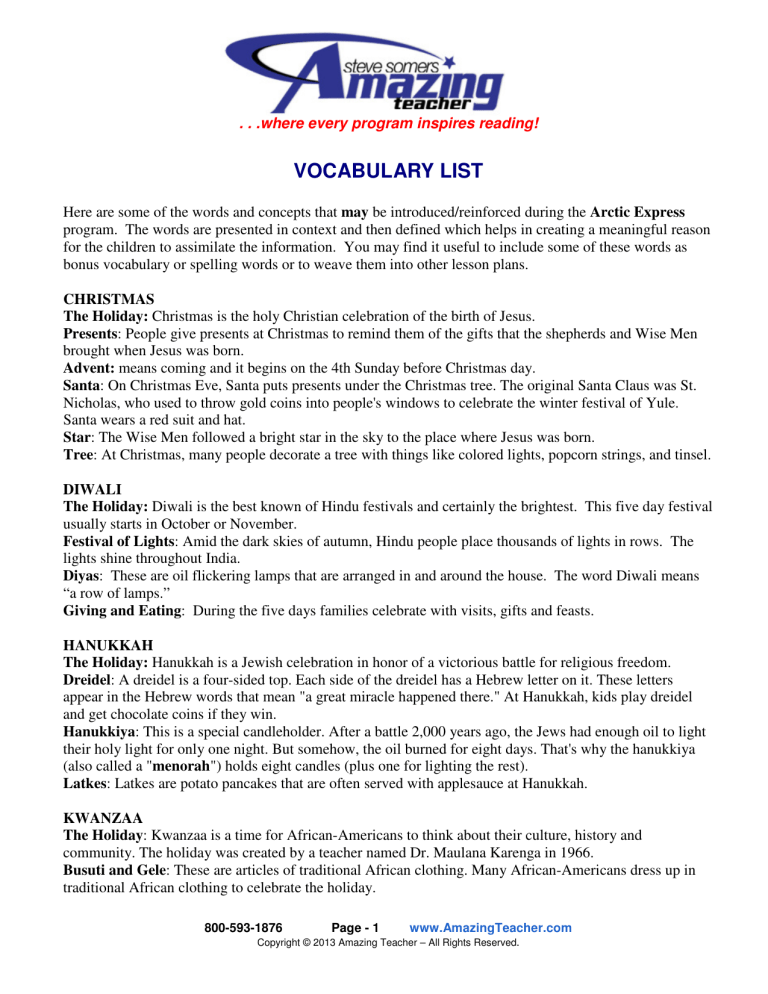
. . .where every program inspires reading!
VOCABULARY LIST
Here are some of the words and concepts that may be introduced/reinforced during the Arctic Express program. The words are presented in context and then defined which helps in creating a meaningful reason for the children to assimilate the information. You may find it useful to include some of these words as bonus vocabulary or spelling words or to weave them into other lesson plans.
CHRISTMAS
The Holiday: Christmas is the holy Christian celebration of the birth of Jesus.
Presents : People give presents at Christmas to remind them of the gifts that the shepherds and Wise Men brought when Jesus was born.
Advent: means coming and it begins on the 4th Sunday before Christmas day.
Santa : On Christmas Eve, Santa puts presents under the Christmas tree. The original Santa Claus was St.
Nicholas, who used to throw gold coins into people's windows to celebrate the winter festival of Yule.
Santa wears a red suit and hat.
Star : The Wise Men followed a bright star in the sky to the place where Jesus was born.
Tree : At Christmas, many people decorate a tree with things like colored lights, popcorn strings, and tinsel.
DIWALI
The Holiday: Diwali is the best known of Hindu festivals and certainly the brightest. This five day festival usually starts in October or November.
Festival of Lights : Amid the dark skies of autumn, Hindu people place thousands of lights in rows. The lights shine throughout India.
Diyas : These are oil flickering lamps that are arranged in and around the house. The word Diwali means
“a row of lamps.”
Giving and Eating : During the five days families celebrate with visits, gifts and feasts.
HANUKKAH
The Holiday: Hanukkah is a Jewish celebration in honor of a victorious battle for religious freedom.
Dreidel : A dreidel is a four-sided top. Each side of the dreidel has a Hebrew letter on it. These letters appear in the Hebrew words that mean "a great miracle happened there." At Hanukkah, kids play dreidel and get chocolate coins if they win.
Hanukkiya : This is a special candleholder. After a battle 2,000 years ago, the Jews had enough oil to light their holy light for only one night. But somehow, the oil burned for eight days. That's why the hanukkiya
(also called a " menorah ") holds eight candles (plus one for lighting the rest).
Latkes : Latkes are potato pancakes that are often served with applesauce at Hanukkah.
KWANZAA
The Holiday : Kwanzaa is a time for African-Americans to think about their culture, history and community. The holiday was created by a teacher named Dr. Maulana Karenga in 1966.
Busuti and Gele : These are articles of traditional African clothing. Many African-Americans dress up in traditional African clothing to celebrate the holiday.
800-593-1876 Page - 1 www.AmazingTeacher.com
Copyright © 2013 Amazing Teacher – All Rights Reserved .
. . .where every program inspires reading!
Corn : Corn is a special symbol of Kwanzaa. One piece of corn is put on the mkeka for each child in the family.
Kikombe : A "Kikombe cha umoja" is the special cup of unity to celebrate the community of African-
Americans.
Kinara and Mishumaa Saba : A kinara is a special candleholder that holds seven candles called mishumaa saba.
Mkeka : A mkeka is a traditional Kwanzaa mat. Objects that are symbolic of Kwanzaa are placed on the mat.
Seven Principles : each day of Kwanzaa is devoted to one of the following seven principles: Unity, Selfdetermination, Collective Work and Responsibility, Cooperative Economics, Purpose, Creativity and Faith.
NEW YEAR
The Holiday : Celebrating the start of a new year began in ancient times to mark the end of winter.
Resolutions : A resolution is like a decision. At the beginning of a new year, people often make decisions about things they plan on doing over the next year.
Parties : Lots of people dress up in party clothes and wear sparkly hats and tiaras to New Year's Eve parties. There's usually fun and yummy food at these celebrations, too!
Noisemaker : At midnight, everyone yells "Happy New Year," makes lots of noise and throws confetti up in the air!
RAMADAN and EID UL-FITR
The Holiday : Eid ul-Fitr is the Muslim celebration that follows the Fast of Ramadan. Ramadan is the ninth month of the Islamic calendar. Muslims believe that during the month of Ramadan, their holy book (the
Quran) was sent from God to guide the people.
Fast : To fast is to avoid eating or drinking. During the Islamic month of Ramadan, Muslims do not eat or drink anything from sunrise to sunset.
Quran : The Quran is the Muslim holy book.
Ma'amoul : These are cookies filled with dates and nuts and sprinkled with powdered sugar. They are a special treat for Eid.
WINTER SOLSTICE (or YULE)
The Holiday : Winter Solstice is the official first day of winter. It is the shortest day of the year. Winter
Solstice is also called Yule. A long time ago, the Romans had big Yule celebrations.
Candle : People light candles on Winter Solstice to symbolize sunlight.
Mistletoe : Mistletoe is used as a Yuletide decoration to symbolize peace and love. But watch out -- it's poisonous!
Warm Winter Clothes : Since Winter Solstice is celebrated in late December, it is usually pretty cold in most parts of the United States and Canada. (But December is summertime in countries south of the equator, like Australia.)
Yule Log : The tradition of the Yule Log began a long time ago when people thought that burning a log would bring good luck.
800-593-1876 Page - 2 www.AmazingTeacher.com
Copyright © 2013 Amazing Teacher – All Rights Reserved .
